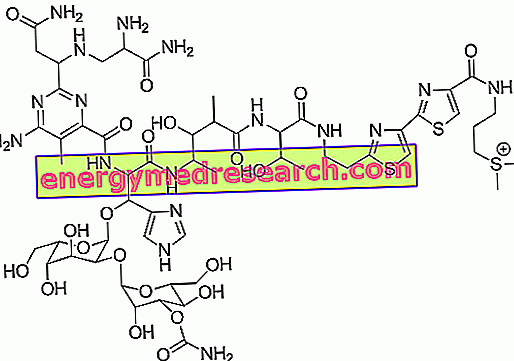Bleomycin is an antitumor antibiotic produced by the bacterium Streptomyces verticillus. This drug is considered to be very important, so much so that it is included in the list of essential drugs prepared by the World Health Organization (WHO). This list contains all the drugs that must be present in a basic health system.

Bleomycin - Chemical Structure
Indications
For what it uses
The use of bleomycin is indicated in the treatment of:
- Hodgkin's and non-Hodgkin's lymphoma;
- Testicular cancer;
- Head or neck cancer;
- Cervical cancer;
- External genital cancer;
- Squamous cell carcinomas.
Bleomycin can be used both as monotherapy and in combination therapy with other anticancer drugs and / or in combination with radiotherapy.
Warnings
Bleomycin should be administered under the strict supervision of a doctor who specializes in the administration of anticancer agents.
Much attention must be paid to the administration of bleomycin in patients suffering from renal dysfunction, as the drug is eliminated through the kidneys.
In patients with manifestations of respiratory failure, great caution should be used when administering bleomycin. Respiratory function should be constantly monitored and serial thoracic radiographs should be performed. Elderly patients may be more susceptible to pulmonary toxicity than bleomycin, so they must be carefully monitored.
Bleomycin can cause fatigue, if this symptom appears it is not recommended to drive or use machines.
Interactions
Bleomycin may reduce the activity of methotrexate (another anticancer medicine).
Vincristine (an anticancer drug) when given concomitantly with bleomycin can increase its activity.
The administration of bleomycin in conjunction with other anticancer drugs, such as - for example - carmustine, mitomycin, cyclophosphamide and methotrexate, may increase the toxicity of bleomycin itself to the lungs.
The use of cisplatin in combination with bleomycin may increase its toxic effects.
Concomitant administration of bleomycin and vinca alkaloids (anticancer drugs, such as - for example - vincristine and vinblastine ) can cause serious damage to circulation in peripheral regions of the body (fingertips and toes, tip of the nose). In the worst case, the affected parts can undergo necrosis.
Bleomycin may reduce the effectiveness of digoxin (a drug used to increase the strength of cardiac contraction).
The concomitant administration of phenytoin (a drug used for epilepsy) and bleomycin may reduce the activity of phenytoin.
The combination of bleomycin and radiation therapy may increase the risk of side effects involving the lungs and skin.
During treatment with bleomycin - if oxygen is given during anesthesia - there is an increased risk of pulmonary toxicity.
Bleomycin and vaccines
The administration of live virus attenuated vaccines in patients receiving bleomycin should be avoided. In fact, treatment with the drug can cause suppression of the immune system. This suppression could cause an inadequate response of the patient to the vaccine; this would allow the attenuated virus to replicate and give rise to viral infections, sometimes even lethal.
Side effects
The type of side effects induced by bleomycin and the intensity with which they occur vary from patient to patient. This happens because of the great variability of response to chemotherapy that depends on the sensitivity of each individual.
The following are the main side effects that can occur after taking the drug.
Mild myelosuppression
Treatment with bleomycin may cause mild myelosuppression (bone marrow suppression). This suppression - albeit slight - leads to a reduction in the production of blood cells (reduced hematopoiesis) which can lead to:
- Anemia (decrease in hemoglobin blood levels), the main symptom of the onset of anemia is the feeling of physical exhaustion ;
- Leukopenia (decreased white blood cell levels), with increased susceptibility to contraction of infections ;
- Plateletopenia (decrease in the number of platelets), this leads to the appearance of bruising and abnormal bleeding with an increased risk of bleeding .
However, this side effect should be transient and bone marrow function should return to normal after termination of therapy.
Flu-like symptoms
These symptoms can also occur several hours after bleomycin. They usually consist of fever and chills and are transient disorders. It could be useful to take antipyretic drugs, such as - for example - paracetamol.
Oral cavity disorders
Following treatment with bleomycin pain, dryness of the oral cavity may occur and small ulcers may appear. To prevent this symptom, it is useful to take plenty of fluids and clean your teeth regularly with a soft toothbrush several times a day. An alteration of the sense of taste may also appear, which should normalize at the end of the treatment.
Skin disorders
Bleomycin therapy can cause rashes associated with itching . You can also witness the hyperpigmentation of the skin, ie the skin may darken. This adverse effect is temporary and regresses within a few months after the end of therapy.
Hyperkeratosis (thickening and hardening of the skin), redness, skin rash, striae, blisters, swelling, change in nail color can also occur.
Alopecia
Bleomycin can cause hair loss. However, this effect is temporary and the hair should begin to grow back shortly after the end of chemotherapy.
Vascular disorders
Bleomycin therapy can cause hypotension, thrombophlebitis and blood vessel obstruction .
Raynaud's syndrome
Bleomycin can cause Raynaud's syndrome. This phenomenon is characterized by a reduction in blood flow in the peripheral vessels of the body. The phenomenon occurs mainly in the fingers and toes, but can also involve other parts of the body. The skin of the affected areas usually takes on a yellow color that can become cyanotic and, finally - once the blood has been restored - it turns red.
Cardiac disorders
Treatment with bleomycin can cause myocardial infarction and inflammation of the pericardium (the membrane surrounding the heart).
Pulmonary toxicity
Bleomycin therapy can induce pulmonary toxicity and promote the onset of pulmonary fibrosis, interstitial pneumonia and inflammation of the pleura (the membrane surrounding the lungs). In some cases, these side effects have been fatal. The symptoms that indicate a possible pulmonary toxicity are cough and / or wheezing ; in case such symptoms appear, it is necessary to consult a doctor immediately.
Pulmonary toxicity may be aggravated by association with radiotherapy.
Gastrointestinal disorders
Bleomycin can cause nausea and vomiting that can be controlled by the use of anti-emetic drugs (antivomit). Furthermore, the drug can promote the appearance of inflammation and / or ulceration of the intestinal mucosa .
Other side effects
Other side effects that may occur following the use of bleomycin are:
- Allergic reactions in sensitive subjects;
- Temperature;
- Pain in muscles and joints;
- Pain in the tumor site;
- Sensitivity and / or swelling of the fingertips;
- Loss of appetite;
- Weight loss;
- Sperm aneuploidy (ie a change in the number of chromosomes in spermatozoa);
- Inflammation of the cerebral arteries (cerebral arteritis);
- Paresthesia (alteration of the sensitivity of the limbs or other parts of the body);
- Hyperesthesia (skin hypersensitivity to stimuli).
Overdose
The symptoms of bleomycin overdose are hypotension, fever, increased heart rate and shock. If you suspect you have overdosed, you should immediately inform the doctor who will decide what to do.
Action mechanism
Bleomycin is able to intercalate in the double strand of DNA.
Once inserted into the DNA, the drug is able to form cytotoxic free radicals (toxic to the cells) that cause the breakup and fragmentation of the DNA itself. At this point, the cancer cell is deprived of the essential macromolecule for its life and dies.
Mode of Use - Posology
Bleomycin is available for intravenous, intramuscular and intra-arterial administration. It appears as a powder that must be dissolved in a suitable solvent just before administration.
Intravenous administration can occur through three different routes:
- Through a cannula (a thin tube) that is inserted into a vein of an arm or hand;
- Through a central venous catheter that is inserted subcutaneously into a vein near the clavicle;
- Through the PICC line ( Peripherally Inserted Central Catheter ), in this case, the catheter is inserted into a peripheral vein, usually of an arm. This technique is used for the administration of anticancer drugs for a prolonged time.
The dosage of bleomycin is strictly individual and must be established by the doctor according to the type of tumor to be treated and according to the patient's condition and clinical picture. Furthermore, the dose administered may vary depending on whether the drug is given as monotherapy or in combination therapy.
Pregnancy and breastfeeding
Bleomycin should not be taken during pregnancy, especially during the first trimester.
Appropriate precautions must be taken - by both sexes - to prevent the onset of possible pregnancies, both during treatment with the drug and for a period of at least three months from the end of the same.
Breast-feeding mothers should not take bleomycin.
Contraindications
The use of bleomycin is contraindicated in the following cases:
- Known hypersensitivity to bleomycin;
- Pre-existing acute lung infection and / or severe lung impairment;
- Pregnant;
- During breastfeeding.



